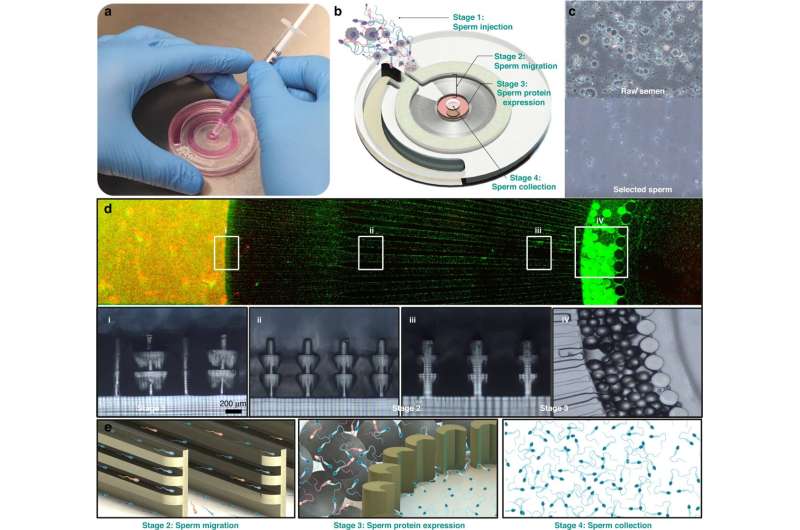Overview of the sperm selection process within the microfluidic device and representative geometry. a Image of the device filled with food dye for visualization. b Schematic overview of the device showing each stage of operation after buffer loading, including stage 1—semen injection into the device, stage 2—sperm migration through layered 3D printed microchannels, stage 3 (optional hybrid version only)—annexin-positive sperm trapping, and stage 4—sperm collection from the center of the chip. c Images before and after the sperm selection process. d Top-down view of the microfluidic device during sperm selection. The sperm were stained using a vitality kit to visualize the migration of live sperm from semen containing dead and nonmotile sperm (left end) toward the center of the chip (right end). Insets I, ii, iii show cross-sections of the 3D printed microchannels at the designated points, while iV shows the magnetic microbead zone top down. e Schematic representation of the major selection mechanisms. Credit: Microsystems & Nanoengineering (2023). DOI: 10.1038/s41378-023-00501-7
Scientists have developed new technology to help couples undergoing in-vitro fertilization (IVF) due to male fertility problems to increase their chances of success in having a baby.
Approximately one in six people worldwide is affected by infertility, according to the World Health Organization, and one in every 22 children in Australia is born via assisted reproduction. With a 78% failure rate, each IVF cycle can be an emotional rollercoaster that often ends in heartbreak.
"Male infertility plays a role in around 30% of cases, due to problems such as low sperm count, reduced motility or movement or poor sperm quality," says Professor Majid Warkiani from the School of Biomedical Engineering at the University of Technology Sydney (UTS).
"While much work has been done around selecting eggs and embryos to boost the success rates of IVF, sperm selection, an essential component in assisted reproduction, is by far the most neglected step in regard to technological innovation," he says.
To tackle this problem, researchers from UTS and NeoGenix Biosciences, a UTS-born start-up, have created and tested a new microfluidic sperm selection device that provides a more reliable process for selecting high-quality sperm. The study results were recently published in Microsystems & Nanoengineering.
Traditional sperm selection methods, such as density gradient centrifugation and swim-up, can cause DNA fragmentation and cell death, leading to unsuccessful IVF cycles.
"This new technology is a 3D printed, biologically inspired microfluidic sperm selection device, which replicates the female reproductive tract and the natural sperm selection process, where only a small percentage of total sperm reach the egg," Professor Warkiani said.
"We conducted extensive testing against conventional IVF selection methods, with the new method showing an 85% improvement in DNA integrity and an average 90% reduction in sperm cell death. The sperm selected by our method also demonstrated better recovery after freezing than traditional methods," he said.
The researchers have partnered with Monash University and Australian IVF clinics to implement the technology into clinical practice. They hope the device will provide help for those struggling with infertility and reduce the number of unsuccessful IVF cycles.
More information: Steven A. Vasilescu et al, Sperm quality metrics were improved by a biomimetic microfluidic selection platform compared to swim-up methods, Microsystems & Nanoengineering (2023). DOI: 10.1038/s41378-023-00501-7
Provided by University of Technology, Sydney
























